On June 10, 1910, Alfred sailed for England,
accompanied by John and Marjorie (his younger brother and wife). He would
be gone almost a year, returning May 15, 1911. His trip took him to
Europe (3 months), British East Africa (3 months), back through France
to England (10 days), and then on to the US (3 months). He sailed on 5
different ships, totaling at least 75 days at sea. On safari for
2½ months, he shot at least 90 animals.
Reconstructed Record: Given Alfred’s penchant for
keeping a diary or notes of each of his many trips and hunts, it seems inconceivable that he
did not leave a record of this his longest, costliest, and most adventurous trip of all. We believe he did keep a diary and that it
was destroyed along with others in which women were mentioned - per photographs, we know women were present on the safaris. Ussing
other sources, we have reconstructed his itinerary:
- His ship passenger tickets show when he undertook
the sea-legs of his trip.
- His list of hotels shows where he stayed
in Europe, Africa, and the United States.
- His signed “Game Register” of animals shot in British
East Africa provides a record of where he hunted and the duration of his safaris.
- The end of Chapter XVIII of his biography provides a glimpse of life on safari. The biography combines two quotes from
a missing diary (see Safaris below) with his brief notes
covering the first 12 days on safari (see Diary below,
in the Roosevelt Big Game Record Book).
Contents:
- Maps - Newland-Tarlton brochure, maps & books on safaris.
- Roosevelt - Big Game Record Book includes an initial
Diary and a partial record of kills.
- Photos - Album Nº3 (Note: use the back-arrow to return here)
- Pg.2 — Game: License,
Laws, & Register; Lists of trophies, Rowland Ward's estimates, etc.
- Pg.3 — Travel:
Ships, trains, & hotels.
- Pg.4 — Supplies, etc: Lists of supplies,
letter of introduction, newspaper article, livestock auction attended, etc.
A note of special thanks: The bulk of the material
for this page was very generously provided us by Stuart Pryor - in 2003!
For which we thank him very much indeed. Some details (e.g. dates) we gleaned from other sources, in
particular the diary of John E. Benitz. We must also thank David & Susan Horner for allowing us to copy
Alfred’s & Olga’s photo albums.
England & Europe
Upon arrival in England, Alfred would certainly have spent time in
London and at the home of
John R. Todd, in Mereside (Bromfield,
Cumberland) planning and preparing for their safari in the British East
Africa Protectorate, today Kenya. Alfred knew Todd from Argentina. They had
also hunted together before, in the Argentine Chaco and Canada's
Yukon Territory. However, per his
list of hotels,
we assume Alfred ever restless also took
the opportunity to visit Scotland (St. Andrews), Ireland (Dublin), Belgium (Ostend, Brussels), Netherlands
(Rotterdam), Germany (Berlin, Dresden), Austria (Viena), and France (Caen, Paris, Marseilles). We do not know
if he was accompanied by Todd or, for that matter, by someone else during his tour of Europe.
Safaris
On the 12th September, Alfred and Todd sailed from
Marseilles to Kilindini, the port of Mombasa,
British East Africa (today Kenya). Alfred's
biography
includes the following quote. The dated format of the quote suggests it is
from a diary (which we have not seen).
“Oct. 4, 1910: (Nairobi): Mr. Todd arrived here after a fair voyage of 19 days from
Marseilles to Mombasa. We have been here three days getting ready for our
start on the safari. On our five hour railway trip from Mombasa we were
continually in sight of big game. The country looks very fine with natural
grazing and everything seems to grow remarkably well. The place (Nairobi) is
full of blacks with most peculiar adornments and paints and often quite
naked. They seem quite a contented lot and go around singing and bucking
about on the least provocation.”
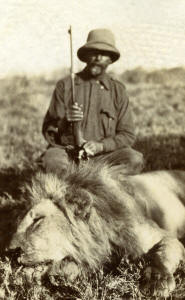
Alfred A. Benitz
British East Africa, 1910
(Source: Susan Horner)
Their safari lasted 2½ months, October 6 to December
21, 1910, and was done in two parts. The first to the north-east of
Nairobi, the second to the west and south. The
maps below show where they hunted.
First Safari — October 6 to November 1
Their first safari took place north-east of Nairobi, along the Thika River, in the Athi River / Donio Sabuk
area, and in the areas around Ithanga and Kilima Mbogo. In the Donio Sabuk, they hunted on the farms of Mr. Versturme and
Major Bunbury almost certainly aquaintances from Argentina.
Mr. Versturme is very likely the Mr. Veturme who, in June 1897, joined Alfred and Todd for a hunt in north Santa Fι, Argentina.
Alfred recorded the first twelve days of the safari (October 6 through 18) in
Roseveldt’s Big Game Record Book (see below). On the 18th a group of porters
returned from a trip to Nairobi bringing a fresh supply of "champagn, whisky, sacks, cartriges". (Did they also bring him a
notebook?)
Alfred's biography includes the following quote; its dated format suggests it is from a diary.
In it he describes hunting around Theika and the Itanga hills, October 8 to November 2. Per his statement
“we got back yesterday”, he wrote this while in Nairobi preparing for the second leg of the safari.
“Nov. 2: Todd and I got back yesterday after 24 days hunting; we went to
Vesturme's place, about 15 leagues from here, to start. We went on eastwards for
1 1/2 days march across the Theika river and near the Itanga hills. I got a huge buffalo
with my 500-bore at about 7 yards; they are very tough animals weighing about a
ton - and awfully "malo" - the most dangerous animals here. There were two
rhinos also killed on the place, their horns measuring 24" and 22 1/4"; a
stupid animal but quite dangerous when they get wind of you and you don't
see them until they are on top of you. Generally they whistle like a steam
ngine when they charge. We are going on to the southern Guaso Nyri. We have
57 men; 1 head man, 2 first gun bearers and 2 second, 2 "boys" (servants), 1
cook, 2 syces, 2 askaris (police) and 45 porters. The porters carry 60 lbs.
and get 1 1/2 lbs. corn meal per day and about three-pence pay. I got about
90 heads and was lucky to get two fine male lions, the list of game being
10 hartebeeste, 3 wildebeeste, 7 impala, 2 waterbuck, 1 common waterbuck, 3
buffalos, 11 wart-hog, 4 Grant's gazelle, 3 rhinos, 10 tommies, 1 eland, 2
bushbok, 3 zebras, 3 Robert's gazelle, 7 topi, 2 dik-dik, 1 baboon, 1 lesser
kudu, 2 Chandler's reedbok, 5 Ward's reedbok, 6 colobus monkeys, 3 lions, 1
cheetah, 1 hyena, 1 jackall. We had a very good time and were in very good
health. I did a tremendous lot of walking. I had no narrow escapes; a herd
of 40 buffalos charged me but I am not sure if they did it on purpose or
not. I shot about 500 shots and did a lot of long distance shooting with
telescopic sights and often got animals 400 to 500 yards away.”
Second Safari — November 5-7 to December 21
It appears that Alfred and Todd took a week's rest
between the two safaris. On Friday, November 4, Alfred
attended a cattle auction
where he noted the exchange rate: £1 = 15 rupees. Per Alfred's official
Game Register, their
safari ended on December 21. Their second safari took place west of
Nairobi. They hunted to the south-west in the Guaso Nyri per that same register near
Lake Natron, and to the north-west in the Loita and Kedong areas (south and east of today's
Maasai Mara Game Park).
After the safaris
Alfred and Todd left Nairobi on or very soon after January 1, 1911. They
sailed from Kilindini to Marseilles,
arriving back in England on about the 20th. Alfred remained in England at most one week. Barely time
enough to arrange with Rowland Ward Ltd. (London) to mount his trophies
Outfitters & Taxidermists
Their safari outfitters were Newland, Tarlton & Co., Ltd..
Alfred's trophies were mounted by Rowland Ward, Ltd. in London (estimated cost: £180
£190). Both companies are still in business and can be found on the web:
-
Newland Tarlton at:
http://DonYoungSafaris.com/
-
Rowland Ward’s web-site is very slow. In your browser, search for: “www.RowlandWard.com”
U.S.A.
It appears that Alfred booked the first available and fastest passage to New
York, for he sailed on the 28th from Liverpool, arriving in New York on February 3rd.
His apparent rush strongly suggests he had received word that his
older brother, Willie, was seriously ill and was in the States seeking
medical treatment. Willie was staying with his in-laws, the Allyn family, in
Corsicana, Texas; he died there on April 1st, of kidney failure. Per Johnnie's diary: “he [Alfred] was with William when he died”.
From Alfred's list of hotels, we gather
that during his 3 months in the States, he visited Washington, New Orleans,
Los Angeles, San Francisco, Fort Ross (California), Santa
Rosa (California), the Grand Canyon, and Boston. He sailed from New York on April 20th, arriving
back in Buenos Aires in early May, 1911. Alfred's trip had lasted almost a year.
Maps & Brochures
The following brochure describes the safari experience in British East Africa
(Kenya). The brochure was provided to Alfred by his outfitters, Newland, Tarlton & Co., Ltd.
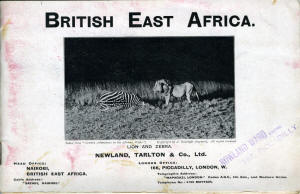
Brochure of British East Africa
Newland, Tarlton & Co., Ltd.
(Source: Stuart Pryor)
|
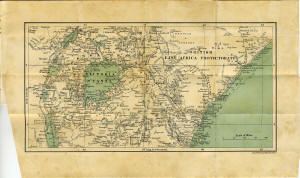
Brochure's map of British East Africa
Stanford's Geog. Estab., London.
(Source: Stuart Pryor)
|
Other references worth noting:
Hunting in British East Africa by Percy C. Madeira, published by J.B.
Lippincott & Co., 1909. Madeira and his wife went on safari three years prior to Alfred
and Todd, beginning in November, 1907. Madeira's safari took place in north-eastern BEA,
whereas Alfred went east, then west and south of Nairobi. The book is available
(free) in PDF format on the web; it is well illustrated with many of Madeira's photos.
NOTE: If someone has Alfred's copy, keep it — likely a first edition, it is worth
plenty today.
Camera Adventures in the African Wilds by A. Radclyffe Dugmore,
published by Doubleday, Page & Company, New York, 1910. Includes 140 photograhs,
some are featured in the above Newland, Tarlton & Co. brochure. The book is
available on the web (not free).
The movie Out of Africa (made in 1985, Oscar winner) depicts
the countryside, safaris, and colonial life-style of that period. It is based upon
the life of Danish author Karen Blixen and takes place c.1910 in and around Nairobi.
Search the web for "Masai Mara" — there are many sites with
excellent photos of the wildlife and scenery.
The following two maps are from Alfred's copy of Madeira's book:
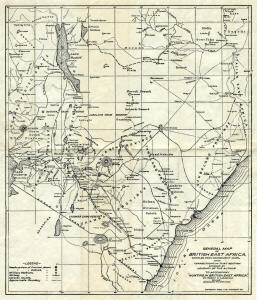
British East Africa, 1909
(Source: Stuart Pryor)
|
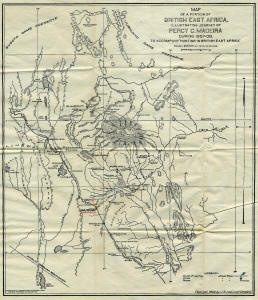
Percy C. Madeira's Safari, 1907
British East Africa
(Source: Stuart Pryor)
|
The map below is an excerpt of the south-west quarter of
Madeira's safari map (above right). We inserted in bright blue
the place-names where Alfred did his hunting, determined from the list of his
kills submitted to the BEA authorities. The colored pencil markings (red
and blue) were most likely made by Alfred for they match his diary entries.
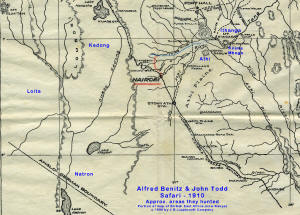
Alfred Benitz & John Todd — Safari, 1910
British East Africa
(Source: Stuart Pryor)
The Roosevelt Big Game Record Book
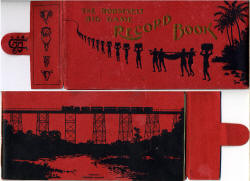
The Roosevelt Big Game
Record Book
Click the image to view a PDF file.
(Source: Stuart Pryor)
During the first weeks of his safari, Alfred recorded his kills
and a brief diary in a brochure prepared for that purpose, The
Roosevelt Big Game Record Book (Teddy Roosevelt's safari was the previous
year, 1909).
Below is a transcription of Alfred's notes - as written. Hand
written in pencil, they can be difficult to interpret. The spelling and punctuation
errors are Alfred's. We highlighted in pale yellow
words in doubt and placed any suggested words in [square brackets].
Record of kills:
(Note: this is NOT a full list of Alfreds kills.)
Saturday
Oct 8 |
1 Wildebeast no 1 with scup.
with scalp.- Athi River
1 hartebeast no 2 no scalp |
|
Monday
Oct 10 |
2 impala with 2 scalps no 3 & 4. - |
Versturmes farm.. |
Tuesday
Oct 11 |
1 Buffalo 44 inch outside
39½ point to point with scalp. no 5 |
Versturne farm |
Wednesday
Oct 12 |
1 wart hog with scalp no 6
1
impala 7 |
Versturmes farm |
| Oct 15 |
1
grants 8 |
|
Oct 16
Sunday |
1
water buck 9
1
wart hog 10
1
wart hog without 11
1
wildebeast with 12 |
North of Athi
|
| Oct 17 |
Rhino & scalp 4 feet, 2 sides, tail no 13
Hartebeest no scalp..
14 |
Bunburry 22Ό 12
|
| Oct 18 |
Warthog (small no good) |
|
| 19 |
Tommie & skin No 15
15
Reed Buck doe (not saved.)
Hartebeest (no scalp) No 16 |
|
| 20 |
Waterbuck 23 w/o m with scalp No 17. |
Found hartebeast head |
| 22 |
Warthog no 18 1 hartebeest no 19 - & scalp. |
|
| 24 |
Eland no 20 no scalp killed by lion. - |
|
| 25 |
Rhino 21 scalp 4 feet 2 pieces of hide. tail
Impalla 22 no scalp skin
Hartebeest 23 |
|
| Oct 26 |
[water]
buck c scalp No 24.- |
|
| 27 |
2
wart hog no scalp 25 & 26
1
female Roan & scalp 27 |
|
28
put in note book |
1 Zebra & scalp & skin 28
1
Rhino
4 feet 29 22Ό |
|
Diary:
The only pieces of Alfred's diary that survive today are two short quotes included in his biography
(see above). And, during the first two weeks of the safari he listed his kills in the “The Roosevlt Big Game Record
Book”:, in which he included the following brief notes. (Per photos, the were ladies present on the safaris.
Any diary in which they were mentioned was likely destroyed to preserve their privacy.) One person Alfred does name is
Mr. V. Bunbury. Per The East African Standard of 10 March, 1923 (see Miscellaneous),
Major Bunbury was one the of the original English settlers of the Donyo Sabuk area in 1904, and that previous to settling in Kenya,
he had ranched in Argentina. It is therefore possible Alfred and/or Todd knew him from Argentina. Either way, he appears
to have befriended them for he gave them permission to hunt on his property (see note on Alfred’s
Game Register).
Zafara left Nairobi on Oct 6th 52 men
---------------
Todd Versturner & I left in coach 6 mules on Oct 7 & went as far as Blue Post
on Thika 30 miles from Nairobi at noon stopped at Scotsloun near motor or
power house.
Oct 8 left Bleu Post & got to Versturnes at Kilima Mbago or
Donansa [Donio] Nabuk (?) Killed a
hardebeest on road 250 yds, & ran a wounded Wildebeast of Todds which
Bunbury finished with his revolver Alfterwards shot a hartebeast at
about 250 yds Todd got 3 wildebeast, 2 wart hog, 1 tommie, 1 steinbok
we camped at Verstumes house.
Oct 10 Todd got 2 hardebeast 1 impala, 1 waterbuck, 1 zebra Went south east &
got 2 impala. Saw lots of game including baboons. Gave Vertumes man 1
ruppee for finding wounded impala.
Oct 11 Went with Bunbury up hill south of his house & scared up a big Rhino which
Todd got Afterwards found a buffalo in Papyrus which AB got. a Rhino
escaped AB afterwards wounded & led us a long chase unsuccessfully.
Oct 12 Tired out in forenoon. In afternoon went out got a wart hog & impala.
Saw 3 giraffes.
Oct 13 Moved camp to Bumburys dam. camp all burned.
Todd got Crocodile, Reed buck & impala & 1 guinea fowl.
Saw 3 giraffe
Oct 14 Sent 10 loads of heads etc to Nairobi. Moved camp higher up on Baranca
as there were a few mosquitos last night.
My mule escaped in morning & spoilt my forenoon.
[Syces] did not come back. Afternoon
tried for Wildebeast on other side unsuccessfully.
Oct 15 Walked up towards Brian Whites house fotografed 7 giraffe. Shot a grants with
telescopic Sight. Men brough mule back.
Oct 16 Sunday
Crossed river & shot 1 wildebeest 3 warthog. 11 water buck. saw hundreds
of animals.
Oct 17
Went towards hill & started up a fine Rhino with big toto & shot him near tent.
horn measurment 22Ό and 12 small one. In afternoon shot a hartebeest
did not take scalp.
Oct 18
Porters got back from Nairobi & 5 exra ones bringing champagn, whisky
sacks, [cartriges] Went on other side &
got a small wart hog. did not take head.







